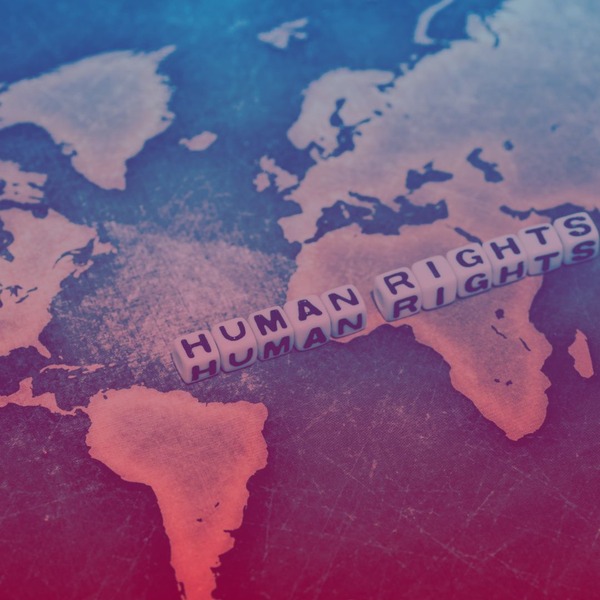
Written by: Elisée Monti, Working Group on Human Rights
Edited by: Benjamin Koponen
The greatest paradox of our time may be that universal human rights are often the first to neglect the individuality they are meant to protect.
In recent years, the divide between the West and the rest has become more pronounced than ever. As a result, the notion of universal human rights becomes increasingly contested, raising fundamental questions about their true meaning. Doubts continue to emerge regarding their definition, origin, impact, and inclusivity. Human rights are often presented as a set of principles that transcend cultural and political divisions. However, this presentation erases the specific historical and ideological contexts which they emerged from. The United Nations defines human rights as “rights inherent to all human beings, regardless of race, sex, nationality, ethnicity, language, religion, or any other status” (United Nations, 2025). However, this definition raises an important question: Is it fair to develop universal principles from a single, predominantly Western perspective, while claiming to account for the differences that make humanity so diverse?
Critics such as Raimon Panikkar (1982), Abdullahi Ahmed An-Na’im (2010), and Heiner Bielefeldt (2000) argue that the Western approach prioritizes individualism over communal values, emphasizing civil and political rights at the expense of economic, social, and cultural ones. Furthermore, Western human rights ideals are often used as a tool of neo-imperialism, with non-Western countries that do not align with these principles facing criticism, trade sanctions, and aid conditions tied to human rights and governance reforms. Border control is only one example. Many Western countries prevent asylum-seekers from entering their territory through strict deterrence measures that often violate the right to seek protection. Within these same countries, access to justice and security is still marked by deep inequalities, especially along racial and socio-economic lines. Yet, the contradiction does not stop at the border. These internal contradictions are reflected in foreign policy, where Western governments often support authoritarian regimes (through trade, military aid, or political partnerships) when it serves their strategic interests. What emerges is that human rights are not applied universally, but are rather used selectively by Western countries to justify interventions, exert pressure on others, and protect their own strategic interests – turning a universal ideal into a tool for maintaining global influence.
In order to determine the validity of these arguments, the origins of human rights must be explored from different perspectives. Then, they must be compared with alternative legal frameworks.
The Roots of Human Rights
In order to understand contemporary human rights, their origins must first be examined. Analyzing their historical and philosophical foundations reveals how these principles have been shaped over time. Furthermore, if human rights are meant to protect the fundamental freedoms of all, one must understand how different societies have addressed this need in their own unique ways. The idea of protecting individuals and communities exists globally. However, the ways in which these protections are defined and enforced vary. Identifying common principles across cultures allows for meaningful comparison. Different cultures throughout history have recognized and protected individual rights in their own ways. The Code of Hammurabi in Babylon (c. 2000 B.C.), the Cyrus Cylinder (539 B.C.), and the Charte du Mande of West Africa (1236 A.D.) are just a few examples. However, present day human rights were influenced by Western political thought, legal systems, and historical context. They were sculpted by ideals from the age of enlightenment. One of these was the belief that all individuals possess natural rights such as life, liberty, and property that exist independently of any government (Locke J., 1689). These ideals became increasingly relevant after the devastation of two world wars. Finally, the vision for human rights grew stronger as nations came together to prevent future atrocities and build a common foundation for justice. These events resulted in the creation of the United Nations and the adoption of the Universal Declaration of Human Rights (UDHR) in 1948.
John Locke (1689), an Enlightenment philosopher, helped to establish the philosophical foundations of human rights. Locke argued that individuals are born with inherent rights that derive from their human nature, not from governments. Other Enlightenment thinkers further developed these ideas. Jean-Jacques Rousseau (1762) stressed the importance of the social contract, insisting that legitimate political authority derives from the general will of the people and must aim to preserve liberty and equality. Similarly, Montesquieu (1748) emphasized the need for a clear separation of powers within government as a safeguard against tyranny and as a means of protecting individual rights (Gay P., 1968).
Those principles gained strength with the American (1776) and French (1789) revolutions. Both of these revolutions laid the foundation for universal human rights by promoting freedom, equality, and the protection of individual liberties (Torpey J.C., 2018). Over time, the pursuit of human rights expanded beyond national revolutions to the international arena. Between 1899 and 1977, a series of landmark treaties in international humanitarian law established clear rules for armed conflict and marked a significant step toward global cooperation. Together, these developments shaped modern democratic societies and strengthened the global commitment to protect human dignity in times of peace as well as conflict (Compass, 2023). Despite the origin of these roots, it is important to acknowledge how poisoned they have been. The very countries that laid the foundations for today’s human rights were also among the first to undermine them, both at the moment of their conception and, disappointingly, still today.
The West and the Rest
The main divide between Western and non-Western contributions to the development of human rights can be explained by a single key factor: it was within Western philosophical thought that human rights evolved from moral concepts into written and enforceable legal frameworks. However, this does not mean that the human rights developed in the Western context are the only ones deserving of such a title. Alternative frameworks have emerged in different regions of the world, reflecting different conceptions of dignity, justice, and social order. Many non-Western traditions emphasize collective welfare, social responsibility, and cultural identity as integral components of human rights. These perspectives emphasize the deep connection between individuals and their communities. They argue that human rights cannot be separated from the specific histories and traditions that shape them. Rather than rejecting the idea of universal human rights, these approaches challenge the notion that there is only one way to define and implement them.
A clear representation of one of these perspectives can be found in the African Charter on Human and Peoples’ Rights adopted in 1981, which sees community solidarity and collective rights as fundamental to human dignity (Amnesty International, 2006). The African Charter reflects the values of many African societies by recognizing that human rights go hand in hand with responsibilities toward one’s community. It also acknowledges that access to development and self-determination are essential parts of human dignity. This reinforces the idea that rights must be understood within real socio-economic contexts.
This emphasis on context-sensitive approaches on human rights is also evident in Asia, where the 1993 Bangkok Declaration emphasized that local traditions and regional histories should be considered when applying human rights principles (Davis M. C., 1996). The declaration argues that different societies interpret and implement rights in ways that reflect their values and lived experiences. Many Asian traditions – particularly in countries such as China, Japan, Thailand, and Vietnam – emphasize social harmony, respect for authority, and collective well-being, shaping conceptions of rights and justice around the primacy of communal stability over individual autonomy.
Some academics support an integrated approach to human rights that balances cultural specificity with universal principles. Instead of being imposed by a single dominant paradigm, scholars such as Abdullahi Ahmed An-Na’im promote a “cross-cultural dialogue” in which human rights norms develop via reciprocal engagement across many cultures (An-Na’im A.A., 2010). According to An-Na’im, a globally recognized human rights framework needs to be flexible and dynamic (An-Na’im A.A., 2010). He argues that it must consider both regional customs and the universal dedication to justice and dignity. Furthermore, the application of universal human rights principles (i.e., equality, dignity, freedom from oppression) must adapt to specific cultural contexts (An-Na’im A.A., 2010).
The practical implementation of this integrated approach can be found in legal systems that combine Indigenous and Western traditions. For instance, in addition to Western human rights standards, the Ubuntu philosophy (which emphasizes community, healing, and collective well-being) is included into South Africa’s post-apartheid legal system. Similar to this, Bhutan’s Gross National Happiness model incorporates social and economic rights into a framework for environmental sustainability and cultural preservation. These scenarios demonstrate that fundamental protections can be preserved while adapting human rights frameworks to align with local contexts and cultural realities. By pursuing a more inclusive and adaptive approach, human rights frameworks can accommodate both universal principles and cultural diversity. This could ultimately ensure that human rights remain relevant, legitimate and effectively implemented in diverse societies.
A focus on the alternative approaches
Cultural perspectives on human rights vary across contexts, and these differences can be understood as strengths rather than weaknesses. Building on this understanding, it is essential to examine the frameworks that challenge, refine, or extend the Western liberal legacy. These methodologies actively influence legal frameworks, models of governance, and social structures around the whole world. Understanding the limits and potential of the universal human rights discourse requires looking at how rights are conceived and applied outside the Western paradigm.
Some non-Western models enhance the global human rights framework by upholding ideals of justice, equality, and human dignity. However, others create conceptual conflicts with “Western” international norms, especially on gender rights and freedom of expression. Analyzing these traditions offers a chance to critically discuss human rights outside of a particular ideological framework. Thus, three alternative approaches to human rights are examined in this section. First, the Indian tradition will be explored. This perspective places human rights within a broader ethical and communal framework. Second, the Islamic approach will be examined. This perspective integrates rights with religious and moral obligations. Finally, the Indigenous Latin American approach will be analyzed. This tradition links human rights to ecological balance and collective well-being.
The Indian approach
The Indian model is a powerful example of how human rights can follow a different logic from Western liberal ideas while still working alongside them. Drawing on the ancient philosophical traditions of Hinduism, Buddhism, and Jainism, the Indian concept of rights is inextricably linked to dharma (duty), collective responsibility, and the interdependence of all beings. In contrast to Western individualism as the source of fundamental rights, the Indian tradition conceives of rights in relation to the moral and social obligations that support a fair society. In practice, this is a society where justice is measured not by individual aspirations alone, but by how well people care for each other and uphold the connections that bind the community together. This perspective rejects the strict division between negative and positive rights, promoting a view of justice that links the dignity of the individual to the well-being of the broader community.
This principle is also deeply rooted in India’s constitutional and legal heritage. While influenced by Western jurisprudence, the Indian Constitution also incorporates indigenous ethical norms such as ahimsa (non-violence) and sarvodaya (universal upliftment). These standards demonstrate India’s unique approach to human rights. It goes beyond civil liberties to include economic, social and cultural rights as an integral part of human dignity. As a result, the Indian tradition provides a critical counterpoint to the Western liberal model, which tends to prioritize individual autonomy and protection from state interference. The Western liberal model also creates a dichotomy between individual and collective rights. The Indian framework challenges this binary and advocates a for a relational approach to justice. Human dignity, in this approach, is realized through social, economic, and ethical harmony (Singh G., 2012). Furthermore, it reinterprets human rights through the lens of shared responsibility, moral obligation, and community welfare. However, there is an interesting contrast between this perspective and the Islamic approach.
The Islamic approach
The Islamic approach is deeply embedded in faith, social harmony, and moral obligation. It holds that human dignity is ensured by divine law (Sharia) and communal responsibility. In contrast, the Western Liberal model focuses on individual autonomy, while the Indian model integrates rights into a broader communal structure. Justice (adl) and human dignity (karamah) are at the core of the Islamic rights framework. They both shape a vision of society where social welfare and the protection of the most vulnerable are fundamental (Bielefeld H., 2000). This approach has something in common with the Indian tradition, as both emphasize positive freedoms. In this way, human rights also include maintaining responsibilities to family, community, and the state.
The Cairo Declaration of Human Rights in Islam (1990) articulates this vision. It reaffirms key principles found in the international human rights system (i.e., the right to life, social protection, equality), and formulates them within the framework of the Islamic moral and legal tradition. Rights are conceived as a part of a comprehensive system that organizes one’s behavior in society. However, while the Indian model has largely integrated its spiritual traditions with modern legal frameworks, the Islamic perspective has sometimes clashed with international human rights norms, particularly in areas such as gender equality and religious freedom. While historically Islamic jurisprudence has granted rights to women, religious minorities, and the poor, in some legal systems today strict interpretations of Sharia law have led to restrictions that contradict universal human rights standards. Issues such as inheritance laws, family rights, and freedom of religion vary widely across the Islamic world, raising ongoing debates about whether human rights should be tied to religious law or remain independent of it.
Despite these challenges, the Islamic model brings a unique and recognizable perspective to the human rights debate. On the one hand, like the Indian approach, it challenges the Western focus on individualism and instead promotes a more communal and relational vision of justice. On the other hand, despite its seeming contradiction, it shares an important similarity with the Western framework. In its more rigid interpretations, it faces the same dilemma of defining what is fair or unfair on the basis of a single, absolute value – a value that varies globally from culture to culture. If liberalism is the foundation of the Western model of human rights, in the Islamic perspective this role is filled by religion.
The Latin American Indigenous approach
Up until now, the alternative models presented – the Indian and Islamic perspectives – have offered complementary insights to the Western human rights framework. While they challenge Western liberalism in fundamental ways, both have, to some extent, engaged with or been shaped by its influence, whether through constitutional frameworks, legal reforms, or modern interpretations of justice. However, the Latin American Indigenous perspective introduces something fundamentally different, perhaps even revolutionary. Unlike the previous models, which still operate within the structures of state governance, law, and societal organization, the Indigenous approach questions the very foundations upon which human rights have been built. It does not simply reinterpret rights through a cultural or religious lens but instead reshapes the way justice is defined, moving beyond human-centered frameworks to embrace a vision that integrates community, environment, and spiritual balance. This perspective forces a radical reconsideration of what it means to live with dignity, exercise rights, and uphold responsibilities not just toward other people, but toward nature and future generations.
Central to this perspective is the Andean concept of Buen Vivir (“good living”), which rejects the Western focus on economic growth and individual accumulation in favor of a collective and ecological vision of well-being (S. Bagni, 2013). This framework does not separate human rights from environmental rights, but sees them as inseparable, arguing that true justice can only be achieved when both people and nature are protected and respected. This radically different approach has been enshrined in the constitutions of Ecuador (2008) and Bolivia (2009), which grant legal rights not only to people but also to nature itself, recognizing ecosystems as legal entities with the right to exist, regenerate, and be free from exploitation.
This perspective does not merely extend the existing discourse on human rights, but forces a reconfiguration of its foundations, moving beyond the legal and political dimensions to embrace a cosmological and ecological understanding of justice. Rejecting the individual-state pairing that defines much of the Western tradition and beyond, it challenges assumptions of human supremacy and the commercialization of nature, offering instead a vision in which dignity, rights and responsibilities are not possessed but rather embodied through balance and reciprocity. At the same time, it poses a profound challenge to the global human rights framework, particularly in a world where economic expansion often takes precedence over environmental integrity. Inevitably, this perspective forces a deeper reflection on the foundations of human rights and underlines, even more in the face of current challenges, the need to rethink justice not only in relation to individuals or societies, but to the planet as a whole.
From theory to reality
When evaluating human rights, theory alone is not enough. To truly understand the effectiveness of different human rights models, it is necessary to examine real-world applications, where principles are tested against historical, political, and cultural realities. Western liberal democracies often present themselves as the model of reference for human rights, championing individual freedoms, democratic governance and the rule of law. However, these ideals do not always translate into practice, and Western states have often failed to uphold the very rights they promote. At the same time, non-Western traditions, often dismissed as incompatible with universal human rights, have produced alternative models that have in some cases proved more effective in promoting human dignity, justice and social harmony.
By exploring both successful and unsuccessful case studies, we can move beyond abstract debates and assess the strengths and limitations of different human rights models. The Bhutanese concept of Gross National Happiness (GNH) and South Africa’s Ubuntu philosophy illustrate how non-Western traditions have developed approaches to rights that prioritize well-being, reconciliation, and social cohesion. Conversely, the Iraq War’s human rights violations or the European Union’s failures during the migrant crisis demonstrate that Western human rights frameworks are not always applied consistently, and at times, fail to protect those they are meant to serve. Compared with each other, these cases paint a more complex picture of the international human rights landscape, one that refutes the assumption that Western models are better than others.
The first compelling case study that highlights the success of a non-Western human rights model is the Bhutanese concept of Gross National Happiness (GNH). Rather than economic growth being the primary measure of the success of a nation, Bhutan has instituted an inclusive strategy that integrates cultural preservation, environmental sustainability, and social well-being into policymaking (Ura K., 2015). This model challenges the Western focus on material wealth and individualistic progress by proposing that human rights should also account for collective happiness and long-term sustainability. By incorporating traditional Buddhist values into modern governance, Bhutan offers an alternative to human rights discourse that aligns with community well-being rather than purely individual freedoms.
The second case study examines the concept of Ubuntu in South Africa, a philosophy that emphasizes human dignity through reconciliation and interconnectedness rather than punitive justice (Mokgoro Y., 1998). This concept played a significant role in shaping South Africa’s post-apartheid justice system, more particularly in the establishment of the Truth and Reconciliation Commission (TRC). The TRC’s model of justice (based on truth-telling, restoration and community healing) stood in stark contrast to the Western legal tradition, which accords a place of honor to punitive justice. Ubuntu is expressed outside the TRC in the South African Constitution, where socio-economic rights, collective responsibility, and redress of historical injustices are foregrounded. It is a vision of human justice that emphasizes the importance of social cohesion and mutual recognition as essential tools for overcoming historical conflicts and promoting an inclusive and just society.
Alongside these successful non-Western examples, however, we should not forget the extremely positive impact that the Western model has had in many cases. The European Convention on Human Rights (ECHR) is one of the strongest systems of human rights protection in the world, allowing citizens to take their government to an international court and giving them a level of power and influence they never had before. Similarly, the American civil rights movement illustrates how Western legal systems can be useful in addressing structural injustices and gradually extending human rights protections. The movement sought to end segregation and racial discrimination. By translating legal norms into actionable protections, the movement demonstrated how sustained activism, judicial decisions, and legislative initiatives can work together to promote greater social justice and equity over time. These success stories do not mean, however, that Western models are perfect. There have been instances in which Western countries have failed to live up to their ideals, and their promotion of human rights has reflected the limitations and contradictions of their work.
One of the most high-profile examples of the West’s failure to uphold human rights is the US-led war in Iraq. Legitimized in part on the grounds of extending democracy and human rights to Iraq, the war was characterized by widespread human rights violations, torture, civilian casualties, and regional destabilization. The language of human rights was used to justify military intervention and to obscure geopolitical agendas. Far from spreading security and democracy, the war produced sectarian violence, displacement and protracted instability (Moyn S., 2018).
Another failure of Western human rights advocacy is evident in the European migrant crisis, which began in 2015 and continues to this day. The European Union, which is committed to asylum rights and refugee protection, failed to uphold these principles when faced with a large influx of migrants fleeing war and economic destruction. The crisis highlighted a double standard in the application of human rights, with European states applying selective protections based on political and racial bias. Governments in Hungary and Poland implemented harsh anti-migrant policies, while governments such as France and the UK were criticized for the inhumane treatment of asylum seekers. This disconnect between Western human rights ideals and policy undermines the West as a global leader in human rights.
Taken together, these case studies paint a complex picture. Non-Western models, such as Bhutan’s GNH and South Africa’s Ubuntu, demonstrate that alternative human rights methods can be highly effective, raising the question of whether Western models are the only ones that are acceptable. At the same time, even if Western human rights models have been proved successful, their failures also reveal contradictions in the way these principles are applied in practice. These examples serve to highlight the need for a broader, more inclusive human rights framework, one that is sensitive to cultural differences, mindful of past injustices, and that upholds human rights standards uniformly, rather than selectively, throughout the world.
Conclusions
The vocabulary of human rights stands at the intersection of multiple cultural, philosophical, and historical debates, all of which represent competing yet overlapping visions of justice, dignity, and individual freedoms. Although the dominant model of human rights has been Western liberal in inspiration, alternatives such as Ubuntu’s focus on reconciliation, the Indian understanding of duties as intertwined with rights, and indigenous alternatives that reconcile human dignity with the environment one challenge the assumption that human rights can be understood through a single universal lens. These understandings do not necessarily reject basic human rights principles, but rather require a broader and more expansive foundation that recognizes multiple paths to justice.
The pursuit of a universal human rights system is paradoxical in nature. On the one hand, its universality implies a corpus of principles that transcends cultural, historical, and ideological divisions. On the other hand, the same homogeneous model of human rights risks erasing the very diversity that constitutes humanity. If human rights are to be practiced globally and not merely as rhetoric, they must evolve from their foundations without diverging from the diverse lived experiences they seek to protect. The challenge, then, is not only to determine what constitutes a universal human right, but also to determine how such rights can be exercised in ways that do not recreate earlier hierarchies of inequality and cultural superiority.
Underlying all this controversy is a deep question: can human rights be a common reference point for human dignity without replacing other ethical systems? Some scholars may argue that universality requires replacing competing frameworks, creating a single moral and legal norm to which all cultures must conform. However, this approach is problematic as it risks cultural homogenization and the marginalization of non-Western ethical traditions within the global discourse on justice. The reluctance of some non-Western thinkers to embrace a unified model of human rights is not necessarily a rejection of human dignity as such, but a fear of losing cultural identity and control over defining justice in their own terms. Following this approach, the future of human rights should adopt a more flexible and adaptive approach, acknowledging that universality is not a static goal but an evolving process of continuous negotiation. In order for human rights to become universally applicable, they must transcend their ideological and historical origins and emerge out of a process of cross-cultural encounter and mutual accommodation. Universality here cannot be dictated through a monolithic hegemonic discourse but must evolve through dialogue and mutual recognition.
Bibliography
Amnesty International (2006). A Guide to the African Charter on Human and Peoples’ Rights. Lynx DPM.
An-Na’im A. A. (2010). Human Rights in Cross-Cultural Perspectives: A Quest for Consensus. University of Pennsylvania Press.
Bagni S. (2013). Dallo Stato del bienestar allo Stato del buen vivir. Innovazione e tradizione nel costituzionalismo latino-americano. FILODIRITTO EDITORE
Bielefeldt H. (2000). “Western” versus “Islamic” Human Rights Conceptions?: A Critique of Cultural Essentialism in the Discussion on Human Rights. Sage Publications.
Compass (2012). Manual for Human Rights Education with Young People. Council of Europe.
Davis M. C. (1996). Human Rights in Asia: China and the Bangkok Declaration. Buffalo Journal of International Law.
Gay P. (1968). The Enlightenment: An Interpretation. Librarie Droz.
Locke J. (1689). The Second Treatise of Government.
Mokgoro Y. (1998). Ubuntu and the Law in South Africa. Buffalo Human Rights Law Review.
Moyn S. (2018). Not Enough: Human Rights in an Unequal World. Harvard University Press.
Panikkar, R. (1982). Is the Notion of Human Rights a Western Concept?. Cambridge University Press.
Singh G. (2012). Human Rights in 21st Century Changing Dimensions. Universal Law Publishing.
Torpey J.C. (2018). American and French revolution and their impact on the Social Sciences. Research Gate.
United Nations (2025). What are human rights? United Nation Human Right Office of the Right Commissioner https://www.ohchr.org/en/what-are-human-rights
Ura K. (2015). The Experience of Gross National Happiness as Development Framework. Asian Development Bank.

 The ’Ndrangheta’s Infiltration and Threat to European Institutions
The ’Ndrangheta’s Infiltration and Threat to European Institutions  From Paper to Practice: How Grassroots Norms Undermine Gender Rights in Pakistan
From Paper to Practice: How Grassroots Norms Undermine Gender Rights in Pakistan  Exploited Childhoods: The Role of Global Corporations in Perpetuating and Mitigating Child Labour
Exploited Childhoods: The Role of Global Corporations in Perpetuating and Mitigating Child Labour  Human Rights Challenges in Addressing SLAPPs in Media, NGOs and Journalism in the EU
Human Rights Challenges in Addressing SLAPPs in Media, NGOs and Journalism in the EU 


